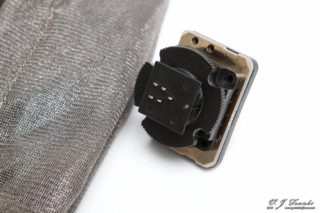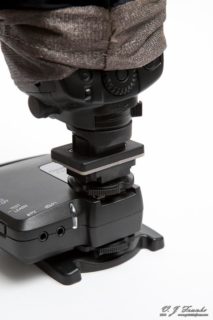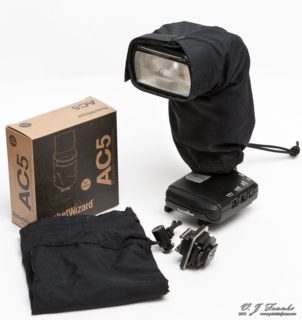PocketWizard AC5 Soft Shield Review
It didn’t take long after the release of PocketWizards ControlTL remotes for the world for photographers and LPA design to realize one of the major issue was the amount of electromagnetic noise produced by many of Canon’s Flashes.
Their first solution was the PocketWizard AC5 soft shield. Currently the AC5 soft shields ship with Mini TT5 transceivers. Unfortunately, if you didn’t get one with your TT5 and haven’t already ordered yours, you may have missed the boat; PocketWizard ended the free AC5 program on April 30, 2010. Mine were ordered as part of that AC5 program, and they took their sweet time getting to me (I enrolled on March 27; I received them on June 15, more than 11 weeks).

The AC5 appears on the outside to be a simple black fabric sock and a small hot-shoe base plate. In fact, it’s not quite so simple. The sock is made from 2 layers of material; the outer layer appears to be normal black fabric. The inner layer, however, is a metallic fabric that contains the EM noise produced by the flash.
The sock/shield seems to be well put together; I can’t find any glaring defects in manufacturing or shoddy craftsmanship at least.
Assembly, if you can call it that is simple. Seat the flash in the hot-shoe filter. Secure the filter to your TT5. Make sure the bungee around the filter is such that the inner fabric contacts the copper plate on the bottom of the filter piece, then tighten the strap around the top of the flash head. If you don’t seat the flash/filter on the TT5 before closing up the bungeed fabric, it becomes difficult to operate the screw-type clamp. Further, the rough edges of the screw-clamp will wear against the metallic fabric.

If you need to maximize the range, reverse the flash head 180° and raise the antenna. LPA Design makes several suggestions on how to improve reception on their website.
The biggest downside to the AC5 is that you can no longer access the controls (well you can push the buttons but can’t see what the settings are since you can’t see the LCD.
With the AC5 in place, the trigger distance was extended to about 300 feet (90 m) for about a 3-fold improvement.
I started my tests firing a single Canon Speedlite 580Ex II into a small palm tree from a MiniTT1 on a EOS 1D Mark 3. With the antenna on the FlexTT5 down, I could reliably trigger the flash out to about 90 feet (28m) on ControlTL channel 1.
PocketWizard suggests that using channels centered around 345 and 347 MHz will improve range somewhat. Since I had the Speedlite setup, I figured I’d give that a shot too. Unfortunately, using channel 2 (345MHz) the trigger distance decreased, though this could certainly be an artifact of other noise sources in environment I was testing in.
With the AC 5 in place, again with the antenna on the receiver down, the trigger distance increased to about 300 feet (90 m) for about a 3-fold improvement. Not quite what Rob Galbraith got, however, I didn’t have the antenna raised which would have further improved reception.

The AC5 definitely improves the range of when noisy Canon flashes are used with ControlTL PocketWizards. However, for me 90 feet of reliable TTL control is almost more than enough for anything I’ve shot so far or see shooting any time soon. However, the AC5 being mostly fabric is tiny, it doesn’t take long to setup and works well enough that I’ll likely be keeping mine in my bag just in case I need them.
Comments
There are no comments on this article yet. Why don't you start the discussion?